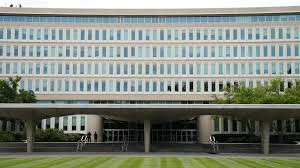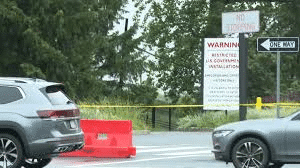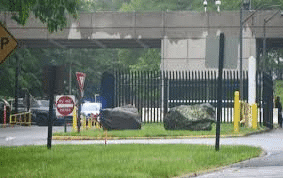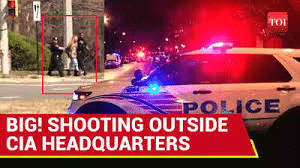
In an extraordinary event at one of the nation’s most secure locations, a car crash turned into a chilling security incident when a woman drove into the gates of the CIA headquarters, resulting in her being shot by security personnel. Such incidents are rare and serious, exposing vulnerabilities that can have broader implications on national security protocols. Exploring the layers of response and prevention measures can provide crucial insights into how security is managed at high-profile government sites.
Security at CIA headquarters is always a top priority, employing an array of robust measures designed to protect both the premises and the sensitive information within. The standard protocols include a vigilant surveillance system, highly trained personnel, and swift responses to any breach. When an incident like this occurs, it compels authorities to reevaluate these protocols and consider all underlying factors, such as the mental health of individuals involved, which can influence such breaches.
This incident not only triggered an immediate response but initiated a comprehensive investigation by authorities to understand the deeper motives and background of the woman involved. As the layers of this investigation unfold, it highlights the need for ongoing evaluations of security strategies to prevent future incidents. This article delves into the details of the crash, security measures, and the broader implications for national security, while also reflecting on public reactions and media representations.
Incident Overview
In the early hours of Thursday morning, a significant security incident unfolded at the gates of the Central Intelligence Agency (CIA) Headquarters in Langley, Virginia. A woman, identified as 27-year-old Monia Spadaro, was shot and wounded after crashing into the CIA entrance gate and disregarding security protocols. Security guards at the facility responded swiftly by opening fire, which resulted in Spadaro sustaining non-fatal gunshot wounds. Initial reports indicate that this incident is not linked to another shooting that happened nearby, involving Israeli Embassy staff members just hours earlier. Authorities, including the Federal Bureau of Investigation (FBI) and other law enforcement agencies, have launched a thorough investigation to explore the circumstances surrounding the crash. They are examining whether Monia Spadaro may have been intoxicated at the time of the incident.
Brief Description of the Crash
The events that led to the shooting began when a vehicle driven by Monia Spadaro crashed into the gate of the CIA headquarters in Langley, Virginia. Spadaro was reportedly heading towards the main entrance of the CIA facility when she ignored multiple orders from security personnel to halt her vehicle. As she approached the gates, the situation escalated rapidly, prompting security officers to open fire in a bid to neutralize the potential threat. This decisive action by the security guards outside the CIA headquarters marked a serious but contained security incident, as officials acted to prevent a possible breach. The focus of the investigation, led by the FBI, is to ascertain whether intoxication played a role in Spadaro’s actions on Thursday morning.
Immediate Security Response
In the wake of the security breach, the response from security personnel at the CIA headquarters was swift and decisive. As Spadaro’s vehicle approached and subsequently crashed into the gate, security officers quickly assessed the threat and engaged by opening fire after orders were disregarded. The main gate of the CIA facility was immediately closed, and employees were redirected to use alternative routes to ensure their safety. This tactical closure was part of wider security protocols to address the immediate threat and secure the CIA premises. Fairfax County police were also actively involved, providing essential traffic control and ensuring that the scene was secure. The FBI’s Washington field office confirmed there was no ongoing threat to public safety, emphasizing that the rapid response effectively managed the potential risks. The shooting at the CIA headquarters occurred just minutes after 4 am local time, showcasing the agility and alertness of agency security officers in neutralizing possible threats to national security.
Security Protocols at CIA Headquarters

The Central Intelligence Agency (CIA) headquarters in Langley, Virginia, also known as the George Bush Center for Intelligence, maintains stringent security protocols to protect its facilities and personnel. Given the sensitivity of its operations, the CIA has encountered numerous security incidents, requiring comprehensive measures to counter potential threats. To understand the crux of these protocols, it is essential to explore the standards and responses adopted to safeguard this critical agency.
Standard Security Measures
At the CIA headquarters, standard security measures are meticulously designed to handle potential threats effectively. Armed security personnel stand on guard, authorized to use lethal force should any vehicle or individual approach the gates in a threatening manner, ignoring orders to stop. This stringent approach was evident in a recent security incident where a woman was shot by security guards for failing to comply with stop directives, underscoring the seriousness with which these measures are enforced.
The main entry gates can be promptly closed during a security incident, with alternate routes quickly communicated to ensure continued operations without compromising security. Assisting the CIA, Fairfax County Police play a significant role in managing traffic around the vicinity, supporting rerouting efforts and enhancing public safety. These shared responsibilities highlight the coordinated efforts between different agencies, ensuring robust area management should any security incident occur.
Response to Security Breaches
In the occurrence of a security breach, the CIA acts decisively to mitigate risks and protect its assets. When a security incident arises, such as when a vehicle approaches the facility in a threatening manner, security guards are authorized to engage the threat. This protocol was recently put into action when a woman, identified as 27-year-old Monia Spadaro, allegedly ignored stop orders and was subsequently shot by security personnel.
Following the shooting, Fairfax Police provided essential traffic management, ensuring both the safety of commuters and the smooth functioning of investigation efforts. The FBI’s Washington field office also responded, contributing to a coordinated law enforcement effort while confirming there was no ongoing threat to public safety. During such incidents, the CIA often keeps the main gate closed as a precautionary measure until it is deemed safe to reopen.
CIA spokespersons generally offer limited details to the media during incidents, prioritizing operational security while investigations are ongoing. This approach ensures that sensitive information is not prematurely disclosed, maintaining the integrity of security operations. While maintaining minimal public announcements, the CIA remains vigilant, continually updating its security strategies to protect against evolving threats.
Details of the Incident
On the morning of May 22, 2025, a significant security breach unfolded at the CIA Headquarters in Langley, Virginia. The incident involved a 27-year-old woman named Monia Spadaro, who crashed into the gates of this high-security facility. Recognized as a major security incident by the CIA, this event drew immediate response from security guards and subsequently sparked an investigation spearheaded by the CIA and FBI. Despite being shot, Spadaro’s injuries were nonfatal, and she was quickly transported for medical treatment. This incident sits within a broader context of heightened security concerns for the CIA, following previous breaches.
Timeline of Events
In the early hours of May 22, 2025, Monia Spadaro attempted to breach the defenses of CIA Headquarters. Around 4 a.m. ET, Spadaro drove towards the gates, disregarding verbal warnings and instructions from security personnel to halt her vehicle. Her actions prompted CIA security guards to open fire. Preliminary identification confirmed her as a 27-year-old U.S. citizen. Following the shooting, reports by NBC News indicated that her condition was not critical, and she received necessary care for her injuries. Additionally, law enforcement officers investigated the possibility of Spadaro being under the influence at the time.
Warnings Issued to the Woman
Monia Spadaro encountered numerous warnings as she sped toward the gates of CIA Headquarters. Security guards at the agency’s entrance reportedly issued repeated orders for her to stop her vehicle. However, as she failed to comply, a decision was made to engage with force as a protective measure. The situation was immediately classified as a security incident by the CIA, prompting a rapid lockdown of the site. Fairfax County police were also called in to assist with managing traffic in the aftermath, ensuring both the safety and security of the premises and its surroundings.
Causes of Security Alert
This breach at the CIA Headquarters is tied to a broader increase in security alerts faced by the agency. Monia Spadaro’s actions, specifically her failure to heed warnings, led to a robust security response. The incident just after 4 a.m. necessitated the temporary closure of the agency’s main gate. It was revealed that Spadaro had a history of driving under the influence, which might have contributed to her reckless behavior. While no direct connection was found between this event and the recent shootings of two Israeli Embassy staff members in Washington, D.C., such incidents underscore a growing concern for law enforcement agencies. The FBI is meticulously examining all aspects of the case to draw further conclusions.
Role of Mental Health in Security Breaches
Security breaches are not uncommon, especially in high-security areas such as the headquarters of the Central Intelligence Agency (CIA). While various factors contribute to these incidents, mental health often plays a significant role. A deeper understanding of mental health issues can shed light on the motivations behind actions that breach security protocols. The intersection of mental health and security is complex, and ensuring safe environments requires addressing mental health as a key consideration.
Possible Mental Health Issues
The incident involving a 27-year-old woman, Monia Spadaro, who was shot outside the CIA Headquarters after crashing her vehicle into the agency’s gates, highlights the potential role that underlying mental health issues may play in security breaches. While specific details about Spadaro’s mental health were not disclosed, such incidents often raise questions about an individual’s psychological well-being. In cases where erratic or inexplicable behavior surfaces, mental health evaluations can be pivotal in preventing security incidents. Understanding whether mental health played a role can inform future preventative measures to improve security protocols and mental health awareness.
Importance of Mental Health Evaluations
Mental health evaluations are a critical tool in identifying individuals who may pose a risk to themselves or others. In high-security areas like CIA Headquarters, effective mental health assessments help preemptively address potential threats. By identifying risk factors early on, these evaluations can prevent situations from escalating into violent incidents.
A robust mental health system plays an essential role in averting tragedies, as it allows law enforcement and security personnel to gain insights into a person’s psychological state. This information can inform policy improvements aimed at enhancing security measures. Additionally, early interventions in mental health can manage conditions that might otherwise lead to dangerous actions, thereby upholding public safety. Understanding the mental health backgrounds of those involved in security incidents, like the one involving Spadaro, is paramount in preventing similar occurrences in the future.
Investigation and Authorities’ Actions

A recent event at the CIA Headquarters in Langley, Virginia, has drawn significant attention, as security measures and law enforcement actions were put to the test. The incident involved a woman driving towards the agency’s main gate, categorized by the CIA as a security incident. This occurrence led to an engagement by security personnel, who opened fire on the vehicle as it approached the entrance despite repeated orders to stop. The response entailed a temporary closure of the main gate and redirection of the regular traffic routes for the employees. In response to the incident, Fairfax County police provided vital traffic control support, aiding the CIA in their ongoing investigation. The FBI’s Washington Field Office also confirmed their involvement, emphasizing that there was no enduring threat to public safety from this isolated event. Notably, both the CIA and its spokespersons have kept detailed information under wraps, particularly regarding whether the woman in the vehicle was harmed during the exchange.
Ongoing Investigation Details
The early morning incident at the gates of the CIA headquarters involved the woman continuing her approach despite clear instructions to halt, prompting security personnel to fire upon the vehicle. The situation unfolded shortly after 4 a.m. local time, with the woman driving towards the secured compound, leading to a defensive response by the agency’s security officers. Thankfully, the vehicle did not gain entry into the CIA compound, and no security personnel were harmed during the ordeal. The FBI has taken the lead in investigating the circumstances surrounding the incident, with confirmation from a source familiar with the ongoing inquiry. Throughout this process, Fairfax Police have played a crucial role by providing traffic support, maintaining order while the CIA probes deeper into the events that transpired at the main entrance.
Woman’s Background and Motives
The individual involved in the CIA gate incident has been identified as Monia Spadaro, a 27-year-old woman. Preliminary investigations by law enforcement officials are exploring whether intoxication might have played a role in her actions, which led to the dramatic confrontation at the CIA entrance. Public records indicate a history of driving under the influence associated with Spadaro, which is being scrutinized to better understand her motives and state of mind during the incident. The confrontation unfolded during the early hours of the morning when Spadaro drove towards the gates, disregarding commands to stop her vehicle, which resulted in security personnel opening fire. She was subsequently shot, detained by security forces, and taken into custody. Current reports state that Spadaro is in stable condition, as authorities continue to investigate the motives and background tied to this significant security breach.
Implications for National Security
The shooting incident at the CIA Headquarters, involving a woman crashing into the agency’s gate, has raised critical questions about potential security vulnerabilities at highly sensitive national security sites. This event underscores the urgent need for reviewing and possibly revamping entry protocols to prevent similar events in the future. Although the crash did not result in fatalities, it managed to disrupt operations significantly by forcing the closure of the main gate, with employees being redirected. Such disruption impacts the critical operations of the Central Intelligence Agency, highlighting a need for proactive measures. The involvement of multiple law enforcement agencies, including the Federal Bureau of Investigation (FBI), in managing this crisis indicates the complex nature of defending national security sites from non-traditional threats. This incident comes on the heels of a security breach involving the shooting of embassy staffers, suggesting a potentially increased threat level in the capital. Moving forward, ongoing investigations will be pivotal to understanding the motivations and implications of these incidents, impacting future security strategies.
Security Vulnerabilities Exposed
The security incident at the CIA headquarters was triggered when a woman drove towards the gates, disregarding security orders to halt. Upon her advance, security guards engaged with the 27-year-old Monia Spadaro outside the main gates of the agency’s headquarters in Langley, Virginia. The confrontation escalated to shots being fired, leading to Spadaro sustaining nonfatal gunshot wounds. This led to the immediate closure of the main gate, compelling CIA employees to take alternative routes for their safety and continuity of operations. This breach highlights the existing vulnerabilities in the security protocols of such a critical national security site.
Agencies like the FBI’s Washington field office responded to the incident to evaluate its impact on public safety, confirming that there was no ongoing threat. This swift response highlights the crucial role of inter-agency coordination during such incidents. The breach and subsequent shooting exposed the need for continuous assessment and strengthening of security measures, ensuring that the CIA’s perimeter is impenetrable to unconventional threats. The event has called attention to the necessity of revising security protocols, ensuring the resilience of highly-guarded facilities.
Reevaluating Security Measures
In light of this recent security incident, there is a clear indication that security measures at the CIA headquarters necessitate a comprehensive reevaluation. The response by security personnel to engage and shoot at the woman as she disregarded orders to stop was immediate, reflecting the trained protocol in such situations. However, the very presence of a breach at the gates emphasizes vulnerabilities that need to be addressed.
Following the incident, security officials decided to close the main gate as an immediate precaution and instructed employees to use alternative routes. The involvement of multiple law enforcement agencies, including Fairfax County police for traffic control, highlights the importance of coordination with local authorities in handling these events effectively. This coordination is pivotal in ensuring public safety and securing sensitive locations.
The FBI’s involvement further assured the public that this isolated incident posed no ongoing threat. However, the frequency of such incidents, including the temporary closures following each security breach, signals a pressing need to enhance current security protocols to prevent unauthorized access. Revisiting and strengthening the protocols not only safeguards national security assets but also mitigates future risks. Continuous improvements and readiness are crucial in preserving the integrity of high-stakes federal entities like the CIA.
Lessons Learned and Future Measures
The recent shooting incident at the CIA Headquarters in Langley, Virginia, underscores the ongoing challenge of maintaining robust security measures at critical government sites. Security protocols were put to the test when a vehicle driven by an individual identified as 27-year-old Monia Spadaro crashed into the gates, prompting a swift response from CIA security personnel. The incident, which ended with Spadaro sustaining non-fatal gunshot wounds, highlighted the effectiveness of existing security measures in neutralizing threats while minimizing harm. As security forces successfully apprehended the suspect, the event served as a critical learning opportunity for law enforcement agencies and underscored the importance of collaboration between agency security and regional police forces, like the Fairfax County Police, who assisted in traffic control during the incident. The shooting at the agency’s gates provides valuable insights into enhancing security protocols and implementing preventive strategies against similar events in the future.
Enhancements to Security Protocols
The incident at the CIA Headquarters revealed key areas for enhancing security protocols at such sensitive locations. Quick engagement by security guards demonstrated effective response tactics to neutralize threats. Additionally, the temporary closure of the main gate and directions for employees to seek alternative routes underscored the need for flexible emergency response plans. This response not only ensured the safety of agency personnel but also provided a case study in effective traffic control during emergencies. Cooperation with local law enforcement, including the Fairfax County Police, illustrated the value of joint efforts in maintaining order and security following such disturbances. The outcome, with non-fatal injuries and a swift apprehension, reflects the importance of continuously refining security strategies while ensuring that agency security officers are well-trained and equipped to handle threats with minimal collateral damage.
Preventive Strategies Against Similar Events
Preventive strategies are crucial in mitigating risks of future incidents at high-security locations like the CIA Headquarters. Key to this is enhancing security protocols that involve securing all gates and rerouting traffic during emergencies. This approach minimizes the risk to staff and visitors, while ensuring operational continuity. The involvement of law enforcement agencies, such as the FBI, in investigations ensures thorough scrutiny and fosters a comprehensive understanding of any security lapses. Additionally, the incident stresses the importance of background checks and intelligence gathering to identify potential threats early. Transparent communication from the CIA about such incidents is pivotal in maintaining public trust while protecting sensitive information. Historical precedents, such as past shooting events near similar facilities, emphasize the necessity for constant vigilance and preparedness to adequately respond to threats, underscoring the critical nature of regulatory compliance and proactive risk management strategies to avert future security breaches.
Public and Media Response

The incident involving Monia Spadaro at the gates of the Central Intelligence Agency headquarters has sparked significant public and media response. Major news organizations like NBC News, CNBC, and Reuters have extensively covered the event, delivering detailed accounts of the situation as it unfolded. This coverage underscores the public’s vested interest in understanding the dynamics of security incidents, particularly when they involve high-profile institutions like the CIA. The shooting of Spadaro, who is reportedly in stable condition, has not only highlighted security protocols but also reshaped discussions around public safety and security in the vicinity of sensitive government installations.
Media Coverage of the Incident
On the day of the incident, a variety of news outlets including NBC News and CNBC reported a shooting at the CIA headquarters. The event unfolded when Monia Spadaro crashed her vehicle into the agency’s gates, leading to a confrontation with agency security officers. According to reports, security guards opened fire when the vehicle continued towards the entrance, marking this incident as a serious security breach. Media platforms like Bloomberg and ABC News closely followed the security incident, providing real-time updates as the situation was handled by multiple law enforcement agencies, such as the FBI and Fairfax County police.
The coverage of this security incident extended beyond immediate reporting, offering further context about Spadaro. Information revealed a prior history of legal issues, which augmented public discourse surrounding the incident. This history was seen by some as a key factor in understanding the motives or circumstances that led to her actions at the CIA gates. Additionally, news outlets reported on a separate but recent shooting involving Israeli embassy staff in Washington, D.C., drawing a connection to broader security concerns. However, these reports confirmed no direct link between the incidents, alleviating some fears of coordinated security threats.
Public Concerns and Reactions
The shooting incident prompted immediate changes in security at the CIA headquarters, with the agency closing its main gate and implementing alternate entry procedures for its employees. These measures addressed initial public safety concerns, ensuring both internal and external stakeholders that the situation was under control. Despite the heightened security measures, the FBI publicly assured the community that the incident did not pose any ongoing threat, which helped to ease broader public anxiety.
Security guards’ quick response in opening fire, when Spadaro’s vehicle continued its trajectory, underscored existing tensions and the need for rigorous security protocols in such high-security areas. This response, managed by law enforcement agencies including the FBI and the Fairfax County police, involved coordinating traffic control and securing the vicinity of the CIA headquarters. The prompt response minimized the incident’s impact and was essential in maintaining the security of the headquarters building.
While there were initial concerns about a potential connection to the shooting of Israeli embassy staff in Washington, D.C., further investigations revealed no apparent link between the two incidents. This finding was significant in preventing undue panic and fears of a broader, coordinated security threat. In the wake of the incident, public discussions have often revolved around the balance between maintaining strict security measures and ensuring normalcy in high-security government zones. We proudly serve injury victims in Aiken, Anderson, Columbia, Myrtle Beach, North Augusta, Orangeburg, and Summerville. If you’ve been injured due to someone else’s reckless or criminal behavior, our experienced attorneys are here to help you seek justice and recover the compensation you deserve. Let Ted Law Firm help you file a successful claim for emotional damages.
Attorney Ted Sink, founder of The Ted Law Firm, is a Yale, Stanford Business School, and Charleston School of Law graduate and former marketing executive who built a 7-figure law practice, earning millions for his clients. With experience in both law and advertising, Ted has been recognized in Forbes, Entrepreneur, and the ABA Journal. He speaks at industry conferences on marketing and law firm management, sharing insights from his unique background to help other firms grow. When not working, Ted enjoys traveling, diving, and dog-sitting golden retrievers.

